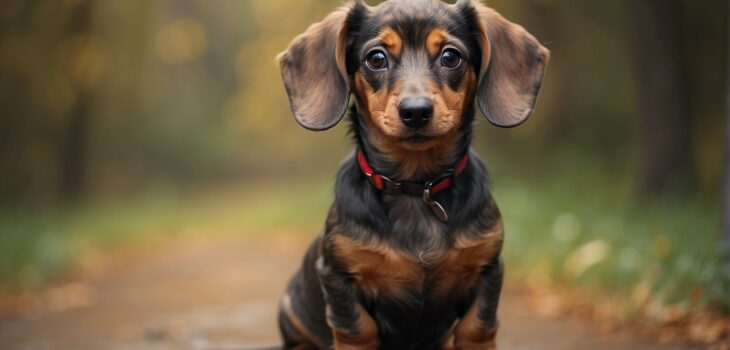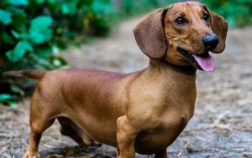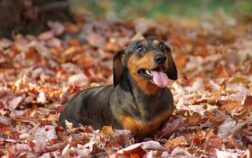Are you curious about the different types of Dachshunds? Well, wonder no more! This article will shed light on the various variations of this beloved breed. From the miniature to the standard, smooth-haired to wire-haired, and even long-haired Dachshunds, each type brings its own distinctive charm. So, whether you’re a lifelong fan or just discovering these adorable dogs, get ready to learn all about the fascinating world of Dachshunds!
Smooth-haired Dachshunds
Description
Smooth-haired Dachshunds, also known as short-haired Dachshunds, have a sleek and shiny coat that lies close to their body. They have a long and muscular body with short legs, making them easily recognizable. Their head is elongated, and they have almond-shaped eyes and a lively expression. Smooth-haired Dachshunds come in a variety of colors, including red, black and tan, chocolate, and more. They typically weigh between 16 and 32 pounds and stand around 8 to 9 inches tall at the shoulder.
Temperament
Smooth-haired Dachshunds are known for their friendly and outgoing nature. They are affectionate, social, and enjoy being around their human companions. They are often described as being lively and courageous, which can sometimes border on stubbornness. However, with proper training and socialization, they can make excellent family pets. Smooth-haired Dachshunds are known to be good with children and other pets, making them a great choice for families.
Care
Smooth-haired Dachshunds have a short coat, which makes grooming relatively easy compared to other coat varieties. Weekly brushing will help keep their coat healthy and minimize shedding. They have sensitive skin, so it’s essential to use mild shampoos and avoid harsh chemicals. Regular exercise is crucial to keep them physically and mentally stimulated. This breed may be prone to obesity, so a balanced diet and portion control are necessary to maintain their weight and overall health.

Health Concerns
Smooth-haired Dachshunds are generally considered a healthy breed but may be prone to some health issues. They are susceptible to intervertebral disc disease due to their long spine, which can lead to mobility problems. Other potential health concerns include obesity, heart problems, and dental issues. Regular veterinary check-ups, a nutritious diet, and an active lifestyle can help prevent and manage these potential health concerns.
Wire-haired Dachshunds
Description
Wire-haired Dachshunds have a distinct coat that is rough and wiry, giving them a charming and unique appearance. Their double coat consists of a dense and wiry topcoat and a softer undercoat. This coat type provides them with protection from rough terrain. Wire-haired Dachshunds come in various colors, including wild boar, black and tan, chocolate, and more. They typically weigh between 16 and 32 pounds and stand around 8 to 9 inches tall at the shoulder, similar to their smooth-haired counterparts.
Temperament
Wire-haired Dachshunds share many characteristics with smooth-haired Dachshunds in terms of temperament. They are typically friendly, outgoing, and affectionate. However, wire-haired Dachshunds may have a slightly more independent streak and can be more stubborn at times. Proper training and early socialization are essential to ensure they become well-rounded companions. They are generally good with children and other pets, but their independent nature may require careful introductions and supervision.
Care
The wiry coat of wire-haired Dachshunds requires more grooming than smooth-haired Dachshunds. Regular brushing is necessary to prevent matting and tangling of the coat. Some owners choose to hand-strip the coat, a process that involves removing dead hairs by hand, to maintain the desired texture and appearance. Occasional professional grooming may also be required to trim their coat. Regular exercise, a nutritious diet, and routine veterinary care are vital to their overall well-being.

Health Concerns
Wire-haired Dachshunds are generally a healthy breed but may be prone to certain health issues. Like other Dachshund varieties, they are at risk of intervertebral disc disease due to their long spine. Eye conditions such as progressive retinal atrophy and cataracts can also occur in some wire-haired Dachshunds. Regular eye examinations and preventive measures, such as preventing obesity and providing joint support, can help manage potential health concerns.
Long-haired Dachshunds
Description
Long-haired Dachshunds possess a beautiful and luxurious coat that cascades along their body. Unlike the smooth and wire-haired varieties, their long hair covers their entire body, including their ears and tail. They come in a variety of colors and patterns, similar to other Dachshund types. Long-haired Dachshunds have a similar body structure to other varieties, with a long back and short legs. They typically weigh between 16 and 32 pounds and stand around 8 to 9 inches tall at the shoulder.
Temperament
Long-haired Dachshunds share the friendly and affectionate temperament found in other Dachshund varieties. They are known for their loving and loyal nature, making them great companions. They can be a bit more reserved and sensitive compared to their smooth and wire-haired counterparts. Early socialization and positive reinforcement training are crucial to building their confidence and ensuring they are comfortable in various situations. With the right upbringing, they can thrive in families with children and other pets.
Care
The long and flowing coat of long-haired Dachshunds requires regular care to keep it healthy and tangle-free. Daily brushing is essential to prevent matting and remove loose hairs. Paying extra attention to the ears and tail, where the hair is longer, is crucial to prevent tangles and matting in these areas. Occasional baths and professional grooming may be necessary to maintain the coat’s beauty. They require regular exercise and mental stimulation, along with a nutritious diet to stay healthy.
Health Concerns
Long-haired Dachshunds, like other Dachshund varieties, are prone to intervertebral disc disease due to their elongated spine. Regular veterinary check-ups and preventive measures, such as maintaining a healthy weight and avoiding strenuous activities, can help manage this risk. They may also be susceptible to other health concerns, including obesity, dental issues, and eye problems. Proper dental care, regular exercise, and a balanced diet are essential for their overall well-being and longevity.
Miniature Dachshunds
Description
Miniature Dachshunds are a smaller version of the standard Dachshund breed, with the same distinctive features but in a more compact size. They have a similar body structure, with a long back and short legs, but stand only around 5 to 6 inches tall at the shoulder and typically weigh between 9 and 11 pounds. Miniature Dachshunds come in various coat types, including smooth-haired, wire-haired, and long-haired, with a wide range of colors and patterns available.
Temperament
Miniature Dachshunds have a personality that matches their larger Dachshund relatives. They are lively, affectionate, and often exhibit a brave and curious nature. Miniature Dachshunds are known for their friendly and playful behavior, making them excellent companions for individuals, couples, and families alike. They are generally good with children and other pets if properly socialized from an early age.
Care
The care requirements for Miniature Dachshunds vary depending on their coat type, whether smooth-haired, wire-haired, or long-haired. However, regardless of coat type, regular exercise is crucial for maintaining their overall health and preventing weight gain. They require a balanced diet appropriate for their size and activity level. Grooming needs will also differ between coat types, with long-haired Miniature Dachshunds requiring more attention to prevent matting and tangles.
Health Concerns
Miniature Dachshunds, like their standard-sized counterparts, may be prone to various health concerns, including intervertebral disc disease, obesity, dental issues, and eye problems. Regular veterinary check-ups, a healthy diet, exercise, and preventive measures can help manage and minimize these risks. Miniature Dachshunds have a longer life expectancy compared to standard-sized Dachshunds, with many living well into their teens if provided with proper care.
Standard Dachshunds
Description
Standard Dachshunds, also referred to as full-sized Dachshunds, are the original size of the breed. They have the iconic long and muscular body with short legs, combined with the unique features seen in other Dachshund varieties. Standard Dachshunds come in a variety of coat types, including smooth-haired, wire-haired, and long-haired, with numerous color and pattern options. They typically weigh between 16 and 32 pounds and stand around 8 to 9 inches tall at the shoulder.
Temperament
Standard Dachshunds exhibit the typical Dachshund temperament, which is friendly, affectionate, and courageous. They are known for their loyalty and make excellent family pets. Standard Dachshunds enjoy spending time with their human companions and may develop a strong bond with their primary caregiver. They generally get along well with children and other pets if properly socialized.
Care
Care requirements for Standard Dachshunds vary depending on their coat type, similar to other Dachshund varieties. Regular exercise is crucial for maintaining their physical and mental well-being. A balanced diet appropriate for their age, size, and activity level is essential, as Standard Dachshunds are prone to obesity. Grooming needs will differ based on coat type, with long-haired Dachshunds requiring more attention due to their longer and more prone-to-tangling hair.
Health Concerns
Standard Dachshunds, like other Dachshund varieties, are at risk of developing intervertebral disc disease due to their long spine. Preventive measures, such as controlling their weight, avoiding excessive jumping, and providing joint support, can help manage this risk. Regular veterinary check-ups, dental care, and appropriate exercise can also contribute to their overall health and well-being.
Mixed Breed Dachshunds
Description
Mixed breed Dachshunds, also referred to as Dachshund mixes or “Designer Dachshunds,” are the result of breeding a Dachshund with another breed. These mixed breed dogs often exhibit a combination of traits from both parent breeds. The physical appearance of a mixed breed Dachshund can vary greatly depending on the parent breeds involved. They may inherit the body structure and coat type of their Dachshund parent or lean more towards the other breed’s characteristics.
Temperament
The temperament of mixed breed Dachshunds can be influenced by both the Dachshund parent and the other breed involved in the crossbreeding. It’s essential to consider the traits and temperaments of both parent breeds to understand the potential temperament of a mixed breed Dachshund. In general, mixed breed Dachshunds can exhibit a range of temperaments, from outgoing and friendly to more reserved or independent. Early socialization and training are crucial to shaping their behavior and ensuring they become well-rounded companions.
Care
The care requirements for mixed breed Dachshunds will depend on the specific traits they inherit from their parent breeds. It’s crucial to consider the grooming needs, exercise requirements, and dietary preferences of both parent breeds when caring for a mixed breed Dachshund. Regular veterinary check-ups, proper nutrition, appropriate exercise, and mental stimulation are essential to their overall well-being.
Health Concerns
Mixed breed Dachshunds, like other mixed breed dogs, may inherit health concerns from their parent breeds. It’s essential to be aware of the potential health issues associated with the Dachshund parent breed and the other breed involved. Regular veterinary care, preventive measures, and educating yourself about the potential health concerns can help ensure the optimal health of a mixed breed Dachshund.
Varieties of Dapple Dachshunds
Description
Dapple Dachshunds, also known as merle Dachshunds, have a distinctive coat pattern characterized by spots or swirled patches on a solid base color. These patterns can vary greatly in intensity and distribution, resulting in a unique and visually striking appearance. Dapple Dachshunds can be smooth-haired, wire-haired, or long-haired, and they come in various colors and patterns. The dapple pattern can appear in combination with other coat patterns, such as piebald or brindle.
Temperament
The temperament of dapple Dachshunds is similar to other Dachshund varieties. They are generally friendly, affectionate, and loyal. Dapple Dachshunds may display a more reserved or cautious nature compared to non-dapple Dachshunds, but this can vary depending on their individual personality and upbringing. Early socialization and positive reinforcement training are essential to build their confidence and ensure they interact well with people and other animals.
Care
The care requirements for dapple Dachshunds are similar to other Dachshund varieties. Regular exercise, a balanced diet, and routine veterinary care are essential for their overall health and well-being. Grooming needs will depend on their coat type, whether smooth-haired, wire-haired, or long-haired. Regular brushing, occasional baths, and attention to their dental hygiene are important aspects of their care routine.
Health Concerns
Dapple Dachshunds, particularly those with excessive dapple patterns, may be more susceptible to certain health concerns. They are at a higher risk of developing hearing and vision problems compared to non-dapple Dachshunds. Some dapple Dachshunds may also have increased sensitivity to sunlight, which can lead to sunburn and skin issues. Regular veterinary check-ups and preventive measures, such as protecting them from excessive sun exposure, are vital to their overall health.
Varieties of Piebald Dachshunds
Description
Piebald Dachshunds have a distinct coat pattern characterized by large irregular white patches on a solid base color. These patches can be in various shapes and sizes, creating a visually appealing coat pattern. Piebald Dachshunds can be smooth-haired, wire-haired, or long-haired and come in different color variations. The piebald pattern can appear alongside other coat patterns, such as dapple or brindle.
Temperament
The temperament of piebald Dachshunds is similar to other Dachshund varieties. They are typically friendly, affectionate, and loyal. Piebald Dachshunds may exhibit a similar independent streak seen in other varieties, and early socialization and training are crucial to shaping their behavior and ensuring they interact well with people and other animals. With proper care and attention, they can make loving and devoted companions.
Care
The care requirements for piebald Dachshunds are similar to those of other Dachshund varieties. Regular exercise, a balanced diet, and routine veterinary care are essential for their overall health and well-being. Grooming needs will depend on their coat type, whether smooth-haired, wire-haired, or long-haired. Regular brushing, occasional baths, and attention to their dental hygiene are important aspects of their care routine.
Health Concerns
Piebald Dachshunds may be more susceptible to certain health concerns compared to non-piebald Dachshunds. They are more likely to have vision and hearing impairments, such as partial blindness and deafness, due to the presence of the piebald gene. Regular veterinary check-ups, preventive measures, and early detection of potential health issues are key to ensuring the long and healthy life of a piebald Dachshund.
Varieties of Brindle Dachshunds
Description
Brindle Dachshunds have a distinctive coat pattern characterized by streaks or stripes of darker color on a lighter base color. The brindle pattern can appear in various intensity levels and can be found in smooth-haired, wire-haired, and long-haired Dachshunds. Brindle Dachshunds come in a range of colors, including red brindle, black and tan brindle, and chocolate brindle. The brindle pattern can also occur alongside other coat patterns, such as dapple or piebald.
Temperament
The temperament of brindle Dachshunds is similar to other Dachshund varieties. They are generally friendly, loyal, and affectionate. Brindle Dachshunds may exhibit the same traits as other Dachshunds, such as being lively and courageous. Early socialization and positive reinforcement training are crucial to ensuring they develop good behavior and interact well with people and other animals.
Care
The care requirements for brindle Dachshunds are similar to other Dachshund varieties. Regular exercise, a balanced diet, and routine veterinary care are essential for their overall health and well-being. Grooming needs will depend on their coat type, whether smooth-haired, wire-haired, or long-haired. Regular brushing, occasional baths, and attention to their dental hygiene are important aspects of their care routine.
Health Concerns
Brindle Dachshunds have similar health risks and concerns as other Dachshund varieties. They may be prone to intervertebral disc disease, obesity, dental issues, and other conditions commonly associated with Dachshunds. Regular veterinary check-ups, preventive measures, and responsible ownership can help manage and minimize potential health concerns.
Varieties of Sable Dachshunds
Description
Sable Dachshunds have a unique coat coloration characterized by a variety of shades and gradients. The sable color ranges from light to dark, often with a richer hue on the back and a lighter shade or tipping on the chest, legs, and tail. Sable Dachshunds can be found in smooth-haired, wire-haired, and long-haired varieties and may display other coat patterns, such as dapple or piebald, in combination with the sable coloration.
Temperament
The temperament of sable Dachshunds is similar to other Dachshund varieties. They are generally friendly, affectionate, and loyal. Sable Dachshunds may exhibit similar traits as other Dachshunds, such as being bold and playful. Early socialization and positive reinforcement training are crucial to ensuring they develop good behavior and interact well with people and other animals.
Care
The care requirements for sable Dachshunds are similar to other Dachshund varieties. Regular exercise, a balanced diet, and routine veterinary care are essential for their overall health and well-being. Grooming needs will depend on their coat type, whether smooth-haired, wire-haired, or long-haired. Regular brushing, occasional baths, and attention to their dental hygiene are important aspects of their care routine.
Health Concerns
Sable Dachshunds have similar health risks and concerns as other Dachshund varieties. They may be prone to intervertebral disc disease, obesity, dental issues, and other conditions commonly associated with Dachshunds. Regular veterinary check-ups, preventive measures, and responsible ownership can help manage and minimize potential health concerns.
In conclusion, Dachshunds come in various types and coat varieties, each with its own unique traits and characteristics. Whether you prefer a smooth-haired, wire-haired, long-haired, miniature, standard, mixed breed, or one of the many color and pattern variations, Dachshunds make wonderful companions. With proper care, attention, and early socialization, a Dachshund can bring joy and loyalty to your life for many years to come.




